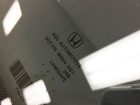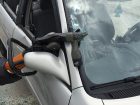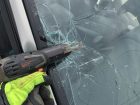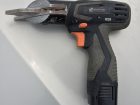
Extrication Tips: July 2018
Chad Roberts
Features Extrication TrainingThis month I’m going to address something that is quietly making a big change in the auto manufacturing industry. While often forgotten about on most scenes, this vehicle component can cause major issues for our patients and the changes that are happening will either help or hamper us depending on how it is dealt with.
Tempered glass and laminated glass have long been staples in the vehicles we see on a daily basis, but with auto manufacturers continuing to add safety features to their vehicles, the one change we are going to address is laminated glass and some of the new areas it’s being added.
Before we talk about glass placement, let’s do a quick overview of the two most common types of glass we find on the road today. Tempered glass is the type of glass that is commonly found in side and rear windows. Generally fairly weak, this glass is easily broken with a simple window punch or by striking with a fine point of a tool. While these windows are beneficial for us as rescuers because of their easy access, the thousands of tiny glass shards that result from its breaking can create a hazard to us and our patients. When not controlled while breaking, these glass shards will be nothing but a headache for rescuers. The other type of glass we encounter regularly is laminated glass. Simply stated, laminated glass is two panes of glass that are sandwiched together with an adhesive. The theory here is when the glass is broken the shards are held in place, hence why this type of glass is found in the windshields of all vehicles on the road, providing a safer option in comparison to tempered glass. Although these tend to be safer, their removal can cause issues for us.
This is where we get into the new changes that are coming into effect. Laminated glass is quickly replacing tempered glass in most if not all new windows all around the vehicle. The theory here being there’ll be less glass shards due to the glass being held together by the laminate, less potential for patient ejection, and less potential for foreign objects to enter the vehicle. In a collision, these attributes far outweigh the continued use of tempered. Now while all of this seems straightforward, we as rescuers have to once again adapt to the changes that have been made.
Laminated glass removal can be accomplished in many different ways and is not new to the fire service. However, with its introduction into more side and rear windows we must find quicker, safer and more efficient ways. The use of new tools like the Ryhno cutter or Beluga cutter are proving to be better options than past tools such as sawzall or glass saw. Use of the first two with the aid of a quick purchase point can quickly get the job done. When removing larger sections of the front or rear windshield, take advantage of previous purchase points made by hydraulic cutters or sawzalls that were used to remove the post of the vehicle. By using these purchase points, we can make a simple cut across the windshield rather than removing the entire windshield. When removing the side laminated windows, instead of removing the entire window, simply make a small purchase point in the bottom corner of the window farthest from your patient’s head. From there make a straight cut along the bottom of the window, then pull the window out and down to remove as the window is not actually attached at the sill. Both of these previous methods do two things. Creating less cuts reduces overall time and less cuts in laminated glass results in less glass dust that can be severely hazardous to our patients and rescuers lungs if inhaled. This being said, if laminated glass is being cut, make sure all patients and rescuers are protected with N95 masks or other similar options.
So, how do we know the difference between tempered and laminated glass? Well, because they are both see through and look very similar we must size up the glass just like we do when breaching a door. Looking for markings in the bottom corner of most windows will offer us this information. If we can’t identify the type of window our best bet is to treat these windows as tempered and use such glass adhesives like Packexe, water ice shield, or even duct tape to hold any possible glass shards together in case the window is in fact tempered.
Another thing to keep in mind before we start thinking about removing windows is that sometimes our most effective option is to leave the glass in all together. Keeping the glass in to protect from environmental elements, or even opening doors before cutting posts if possible are two simple methods. Another option is using previously mentioned window adhesive and leaving the window in place to protect from possible breaking can save us time, as windows that don’t need to be removed to facilitate patient removal will cost us time and create a possible mess and exposure to hazardous glass shards or dust.
While glass removal isn’t exactly the most exciting thing in the extrication world, it’s something we often forget or spend way too much time on completing. By understanding the presence of more laminated glass in vehicles, identifying whether or not the windows need to be removed at all, and identifying which type or window we are dealing with, we can safely and properly mitigate the glass in quick fashion. Removing glass is a process generally sandwiched somewhere in between vehicle stabilization and the actual extrication process, but as always, we must prioritize what’s most important to our patient and their removal from the vehicle. Identify removal, type of glass, and method to remove and move on. Dealing with glass safely can reduce secondary injuries to patients and rescuers and afford us more time on other extrication tasks. Until next time, keep your eyes and ears open and never stop learning.
Chad Roberts is a firefighter in Oakville, Ont., and works on a heavy rescue. He is a member of the Oakville extrication team and competes and trains across North America. chadroberts12@gmail.com
Print this page



